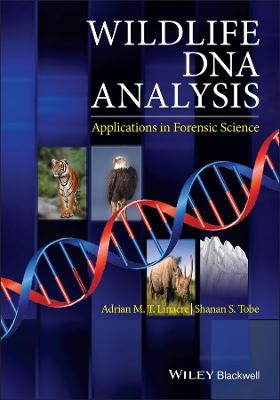
Wildlife DNA Analysis
Wiley-Blackwell (Verlag)
978-0-470-66596-1 (ISBN)
- Lieferbar (Termin unbekannt)
- Versandkostenfrei innerhalb Deutschlands
- Auch auf Rechnung
- Verfügbarkeit in der Filiale vor Ort prüfen
- Artikel merken
WILDLIFE DNA ANALYSIS Applications in Forensic Science
DNA typing of non-human DNA is a fast developing area of research and professional practice. The application of DNA typing in wildlife forensic science is one of these prime uses of DNA typing and is gaining increasing profile. The use of DNA profiling in wildlife forensic science falls into two broad areas: species testing and genetic linkage. Species testing answers the question 'what species is this?' and genetic linkage answers the question 'did these two samples come from the same organism or population?' Wildlife DNA Analysis: Applications in Forensic Science provides an accessible introduction to both of these key areas.
Clearly structured throughout, the introduction highlights the different types of crime where these techniques are regularly used. This chapter includes a discussion as to who performs forensic wildlife examinations, the standardisation and validation of methods, and the role of the expert witness in this type of alleged crime. This is followed by a detailed section on the science behind DNA typing including the problems in isolating DNA from trace material and subsequent genetic analysis are also covered. The book then undertakes a comprehensive review of species testing using DNA, including a step-by-step guide to sequence comparisons. A comparison of the different markers used in species testing highlights the criteria for a genetic marker. A full set of case histories illustrates the use of the different markers used. The book details the use of genetic markers to link two or more hairs/feathers/leaves/needles to the same individual organism and the software used in population assignment. The problems and possibilities in isolating markers, along with the construction of allele databases are discussed. The book concludes with evaluation and reporting of genetic evidence in wildlife forensic science illustrated by examples of witness statements.
An accessible introduction to this fast developing area of research within forensic science.
Case studies throughout to link theory and practice and to highlight the use of DNA testing in species testing.
Covers both crimes against wildlife and offences where wildlife can provide vital evidence.
Assumes only a basic background knowledge of DNA.
Includes a comprehensive review of species testing using DNA, including a step-by-step guide to sequence comparisons.
Adrian M. T. Linacre, Flinders University, Adelaide, Australia Shanan S. Tobe, University of Strathclyde, Glasgow, UK
Foreword ix Preface xi
About the Authors xiii
Acknowledgements xv
1 Introduction 1
1.1 Importance of wildlife forensic science investigations 1
1.2 Role of forensic science in wildlife crimes 3
1.3 Legislation covering wildlife crime 4
1.4 Role of non-human DNA in forensic science 8
1.5 Development of wildlife DNA testing 9
1.5.1 History and current state of wildlife DNA forensic science 10
1.5.2 Wildlife forensic science testing 11
1.5.3 Performing DNA typing in wildlife investigations 13
1.6 Accreditation and certification 14
1.7 Standardisation and validation 20
1.8 Collection of evidential material, continuity of evidence and transportation to the laboratory 24
1.9 Note taking and maintenance of a casefile 29
1.10 Case assessment and initial testing 30
1.11 Scope of book 32
Useful websites 32
References 33
2 DNA, Genomes and Genetic Variation 37
2.1 Introduction 37
2.2 The DNA molecule 37
2.3 Chromosomes and nuclear DNA 39
2.4 Genomes 41
2.4.1 Nuclear DNA 41
2.4.2 Mitochondrial and chloroplast DNA 44
2.5 DNA mutation and genetic variation 47
2.5.1 Genetic variation of repetitive DNA 48
2.5.2 Single base changes leading to genetic variation 48
2.5.3 Genetic loci used in species testing 50
2.6 DNA polymorphisms leading to speciation 53
2.6.1 Genetic isolation 54
2.6.2 Other processes leading to speciation 56
2.7 What is a species? 56
2.7.1 Subspecies 60
2.7.2 Genus to Kingdom 61
2.8 Summary 63
References 64
3 Methods in Wildlife Forensic DNA Analysis 69
3.1 Introduction 69
3.2 Protein polymorphisms 69
3.3 DNA isolation, purification and concentration 70
3.3.1 Generic aspects of DNA isolation 70
3.3.2 Lysis step 71
3.3.3 DNA purification: silica-based extraction 72
3.3.4 DNA purification: Chelex R 100 resin 73
3.3.5 DNA purification: organic extraction 74
3.3.6 Microconcentration 76
3.4 DNA quantification 76
3.5 Restriction fragment length polymorphisms (RFLP) 78
3.6 Methods based on the polymerase chain reaction 81
3.6.1 Factors affecting PCR efficiency and optimisation of PCR 84
3.6.2 PCR-based methods of DNA quantification 88
3.6.3 Random amplification of polymorphic DNA 91
3.6.4 Amplification of fragment length polymorphisms (AFLP) 93
3.7 PCR set-up 95
3.8 PCR clean-up 98
3.9 DNA sequencing 99
3.10 SNP typing 100
3.11 New generation of DNA sequence methods 102
Suggested reading 104
4 Species Testing 105
4.1 Introduction 105
4.2 Species 106
4.2.1 Genetic variation and correspondence with taxonomy 106
4.3 Attributes of a species testing locus 106
4.4 Application of a locus to a species 110
4.5 Tests available and how they are performed 110
4.5.1 Sequencing 111
4.5.2 Species-specific primers 124
4.6 Developing a species test 127
4.6.1 Use of data on GenBank and sequence alignment 128
4.6.2 Designing primers 135
4.6.3 Validation 156
4.7 Interpretation and reporting of results 159
4.7.1 Interpretation and reporting sequencing results 160
4.7.2 Interpretation and reporting species-specific testing results 169
4.8 Other limitations: hybrids and wild/captive bred 171
4.9 Future methodologies 173
References 173
5 Genetic Linkage 177
5.1 Introduction 177
5.2 Whole genome testing 177
5.3 Types of individualisation testing 178
5.3.1 Short Tandem Repeats 179
5.4 Identifying STR loci 182
5.4.1 DNA libraries 183
5.4.2 Locating novel microsatellite motifs using Next Generation Sequencing 184
5.5 Allele databases 190
5.5.1 Number of theoretical genotypes 192
5.5.2 Allelic ladders 192
5.6 Hardy–Weinberg equilibrium 193
5.7 Kinship factors and accounting for shared alleles 199
5.7.1 Rare or absent alleles on the database 202
5.8 Assessing the suitability of STR loci 203
5.8.1 The Genetic Data Analysis software (GDA) 205
5.8.2 The Excel Microsatellite Toolkit 214
5.8.3 Arlequin 220
5.8.4 API-Calc 228
5.8.5 Genepop 230
5.8.6 FSTAT 235
5.8.7 Structure 236
5.8.8 Summary 242
5.9 Genetic assignment: paternity testing 244
5.9.1 Genetic assignment: paternity testing if one parent is not available 249
5.9.2 Genetic assignment in paternity testing, incorporating kinship factor 251
5.10 Concluding comments 253
References 254
6 Interpretation, Evaluation and Reporting of Results 259
6.1 Introduction 259
6.2 Case assessment 260
6.3 Hierarchies of propositions 261
6.4 DNA evidence evaluation 262
6.4.1 The frequentist approach 263
6.4.2 Likelihood ratios 264
6.4.3 The Bayesian approach 266
6.4.4 Comparison of the three approaches 267
6.5 Evaluation of DNA evidence in wildlife cases 269
6.5.1 Case scenario 1 269
6.5.2 Case scenario 2 271
6.5.3 Case scenario 3 272
6.6 Role of the expert witness 273
6.7 Report writing 275
6.8 Summary and comments 277
Statement of witness 278
References 299
Measurements 303
Glossary 305
Appendix A Simulated Sample Populations 311
Appendix B Useful websites 323
Index 325
| Erscheint lt. Verlag | 10.5.2013 |
|---|---|
| Reihe/Serie | Essential Forensic Science |
| Verlagsort | Hoboken |
| Sprache | englisch |
| Maße | 169 x 245 mm |
| Gewicht | 553 g |
| Themenwelt | Informatik ► Weitere Themen ► Bioinformatik |
| Naturwissenschaften ► Biologie ► Genetik / Molekularbiologie | |
| Naturwissenschaften ► Biologie ► Zoologie | |
| Naturwissenschaften ► Chemie | |
| ISBN-10 | 0-470-66596-3 / 0470665963 |
| ISBN-13 | 978-0-470-66596-1 / 9780470665961 |
| Zustand | Neuware |
| Haben Sie eine Frage zum Produkt? |
aus dem Bereich


